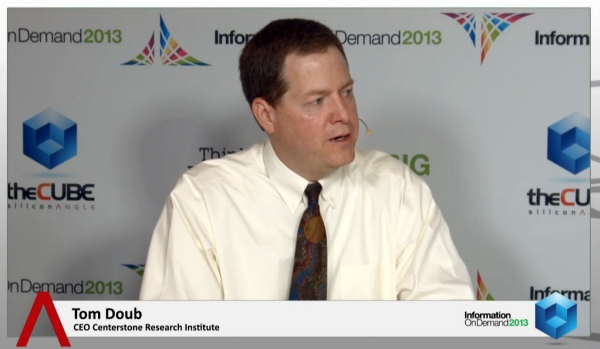 NEWS
NEWS
 NEWS
NEWS
 NEWS
NEWS
![]() For the first day of IBM’s Information on Demand 2013 event in Las Vegas, theCUBE co-hosts John Furrier and Dave Vellante continued the series of interviews with Tom Doub, CEO of Centerstone Research Institute, “a mission-driven, non-profit organization, focusing on bridging the gap between research and practice,” as Doub described it.
For the first day of IBM’s Information on Demand 2013 event in Las Vegas, theCUBE co-hosts John Furrier and Dave Vellante continued the series of interviews with Tom Doub, CEO of Centerstone Research Institute, “a mission-driven, non-profit organization, focusing on bridging the gap between research and practice,” as Doub described it.
“Everyday we learn mountains of new information that come out of research that affect both healthcare and also behavioral healthcare (mental health and substance abuse) and we’re trying to bring that research closer to practice. Big Data is one way that we’ve been doing that,” explained Doub.
Data is obtained from various sources. They could be electronic health records, or even the impact of weather conditions on care delivery models. “When people don’t make it to the clinic due to bad weather, we wonder how can we take that into account and make our business process more efficient,” said Doub. “The real power is bringing in different data sources.”
“We started our analytics journey about five or six years ago. We were very fortunate, as a non-profit, to get investment,” recounted Doub.
“First thing we did, as we started building our data infrastructure, was focusing on key-business problems,” Doub said. “We had several business crisis that we faced: payers were changing the way they did business, the healthcare environment was changing very rapidly, and that created business opportunities for us, as an analytics, to help solve those business problems and demonstrate our value.”
“As a research institute, we took the approach of creating a center of excellence around analytics. Prior to starting our effort we had 3 separate data groups within the organization: the Quality improvement area, the information technology area, and statisticians doing research. We attracted people that were interested in solving key social problems.”
“One of the things that I’m most proud in our effort it’s been our ability and our success in getting staff involved. It’s really about using the information. A model is only so good as it is being used on a day to day basis and it was those business challenges that helped us drive adoption through the user base. We had external pressures that helped us drive the cultural change necessary within the organization to increase and improve our use of analytics throughout the management team,” said Doub.
“We’ve seen tremendous business results. Healthcare is shifting in health reform from an environment where you used to pay a fee for service to payment per value. Value is the equation of dividing the outcome of cure to the cost to achieve it.”
Support our mission to keep content open and free by engaging with theCUBE community. Join theCUBE’s Alumni Trust Network, where technology leaders connect, share intelligence and create opportunities.
Founded by tech visionaries John Furrier and Dave Vellante, SiliconANGLE Media has built a dynamic ecosystem of industry-leading digital media brands that reach 15+ million elite tech professionals. Our new proprietary theCUBE AI Video Cloud is breaking ground in audience interaction, leveraging theCUBEai.com neural network to help technology companies make data-driven decisions and stay at the forefront of industry conversations.